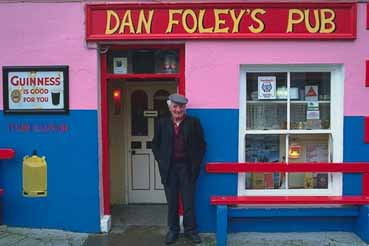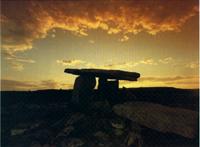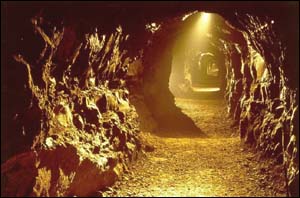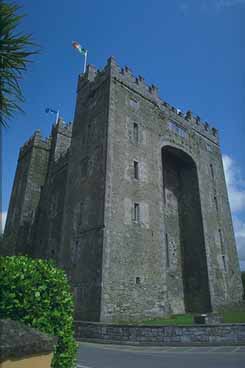
Laccaroe
House


Irish Tourist Board Approved
ABOUT CO. CLARE

bed and breakfast country inns ireland travel
bed and breakfast country inns ireland travel
The River Shannon and Lough Derg form the eastern boundary of County Clare. On the west is the wonderfully varied Atlantic coast, with mighty cliffs, caverns and sandy bays. To the north this rugged coast rises nearly 700 feet above the sea in the sheer Cliffs of Moher; here also is the amazing limestone district called the Burren, with its many caves, underground streams and rare flora. On the south is the broad Shannon estuary, where Ireland's greatest river meets the sea.
bed and breakfast country inns ireland travel
bed and breakfast country inns ireland travel
 THE BURREN
THE BURREN
The thing about the Burren is that it is not obvious. It's not like the Taj Mahal or the Grand Canyon or Ayer's Rock. You could be standing in the middle of it and asking the locals where it is. This has happened. Let's face it, grey stone, green fields and cows is basically what Ireland is to some people, and if you don't do your homework, you too could cycle or drive the length and breadth of the place and feel like you never really saw it. But the homework isn't difficult and you can start right here. The Burren is an amazing place. It is a karst limestone region of approximately 300 sq km which lies in the north west corner of Co Clare, in Ireland. It is composed of limestone pavements, which are eroded in a distinctive pattern known as karren. This pavement is crisscrossed by cracks known as grykes and underneath the pavement there are huge caves and rivers that suddenly flood when it rains. It contains dozens of megalithic tombs and celtic crosses and a ruined Cistercian Abbey from the 12th century, Corcomroe.You can find villages abandoned from famine times and green roads on which you can walk for miles without ever seeing a car . And if you go in springtime you will find rare wildflowers such as gentian and orchids and bloody cranesbill.
The north-west corner of Co.Clare is one of the most interesting and striking landscapes in Europe. It is an area of naked sheets of limestone running into the sea as low cliffs on rocky shorelines , and re-appears as the three Aran Islands at the mouth of Galway Bay. The Burren is interesting from the points of view of geology , archaeology , and botany , as well as being strikingly beautiful in it's bareness.
The Cromwellian general who remarked that there was not a tree on which to hang a man , or enough water to drown him , or enough soil to bury him , was in fact catching the 'feel' of the Burren in a sentence. Modern visitors are less bloodthirsty , and come for the walking , sea-angling , photography and caving that make this corner of Ireland such an attraction. There is so much to the Burren that it could easily sustain a web-site all to itself.
A karst landscape is a limestone region which exhibits many different features , due to chemical and physical weathering and denudation. Denudation is the removal of soils and vegetation from the rock surface leaving large sheets of bare rock. The limestone present in the karst region is carboniferous limestone. This means that the limestone present consists essentially of calcium carbonate. Structure The bedding planes and joints make the rock very vulnerable to weathering as the rock is pervious , and because of this , water can seep through the joints and bedding planes. As limestone is essentially composed of calcium carbonate , and as calcium carbonate is soluble , it is vulnerable to a chemical weathering process known as carbonation. In this process rainwater absorbs carbon dioxide from the atmosphere and thus forms carbonic acid. This acid reacts with the calcium carbonate in the limestone and converts the calcium carbonate into calcium bicarbonate which is removed in the solution , causing erosion. (Other cause of chemical erosion would be by acidic rain or organic life in soils , if present.) The water that carries the calcium bicarbonate seeps and percolates underground and the carbonation process is renewed. When evaporation occurs , calcium carbonate is deposited on the walls and ceilings of underground caverns or caves which themselves are created by carbonation and roof collapse , resulting in features such as stalagmites , stalagtites , dripstones and pillars occuring
bed and breakfast country inns ireland travel
 AILLWEE CAVES
AILLWEE CAVES
bed and breakfast country inns ireland travel
The story of Aillwee Cave began millions of years ago when streams sinking underground on Aillwee Mountain started dissolving channels through the lines of weakness in the limestone. About one million years ago the ice age began and from then until fifteen thousand years ago Ireland's climate alternated between artic coldness and warmer periods, freezing and melting, freezing and melting over the centuries. This melting water roared and crashed it's way through an underground channel greatly enlarging the passage and bringing with it large quantities of sand and silts which are still present in the inner cave today. Aillwee is one of the most ancient caves in the Burren and perhaps in Ireland.
 BUNRATTY
BUNRATTY
It is hard to believe, looking at the quiet little village of Bunratty, that under the village, and the surrounding fields, roads and houses, lie buried the remains of a once flourishing town, centuries of settlement, battles, deeds......and stories. Of the glory of those far off days, what remains is Bunratty Castle, one of the finest tower houses still standing in Ireland.
The castle has had a dramatic and bloody history. Its strategic position on the River Shannon always attracted interest and envy from unfriendly quarters. It changed hands many times, usually violently, during the periods of friction between the native Irish of Thomond and the Norman and Norman-Irish intruders. The castle has been destroyed at least eight or nine times and it has seen many bloody murders. Today, however, there is little evidence of all this death and destruction.
The castle stands peacefully in delightful grounds, the hiuses and cottages at Bunratty Folk Park spread out at the foot of its massive walls, much in the way that cottages and crofts of old would have clustered around its base. The modern visitor to Bunratty Castle approaches along a section of ancient paved road, across the remains of a moat which once surronded the castle, and through a door in the 'bawn' wall into the courtyard, before mounting steps to a drawbridge. Bunratty Folk Park offers a glimpse of an entirely different era. The buildings and atmosphere date from around the year 1900, when the influence of the towns was just begining to percolate through to rural communities. This was a time when news of the horseless carriage had reached the countryside; electricity was known in the town, as was the telephone - although only in large government departments and big businesses - but the new technological revolution had not noticeably affected country life.
Bunratty is alive at night as much as during the day, when Bunratty Castle plays host to the world famous Mediaeval banquets, now in their 34th year, and the Folk Park's barn hosts Traditional Irish Ceili. Elsewhere in the village, you may enjoy one of the local bars. Durty Nellies, known throughout the world, is beside the castle, while the recreated pub of the Folk Park, McNamara's, is open at night. The Fitzpatrick Bunratty Shamrock Hotel's bar is also a very popular local pub where many a good story is told.
 CLIFFS OF MOHER
CLIFFS OF MOHER
For millions of years afterwards sand and mud were washed on top of them and these sediments formed shale and flagstones, which can be best seen at the cliffs of Moher, where they plunge 700 feet to the sea and extend for five miles.Not technically part of the Burren, but close enough to be included.
There aren't many birds to be seen at the Cliffs in winter, but come springtime you can see thousands of guillemots, kittiwakes, fulmars and shags.
The catamaran which sails from Liscannor during the summer does a sunset tour under the Cliffs, which gives you a great vantage point from the sea.
There is an excellent visitors centre at the cliffs which is open year round .
Laccaroe House
Bed and Breakfast
Gurrane
Feakle
County Clare
Ireland
Telephone : 00353 (61) 924150 / Mobile 00353 (87) 2258803
Email : karenbreen1966@yahoo.ie
